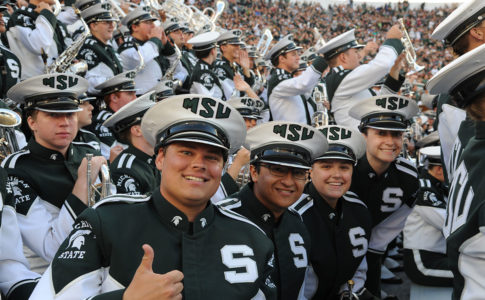Please pause: Before you read this page, make sure to take the quiz. Here are quick and detailed answers.
Quick Answers
1. B
2. A
3. B
4. A
5. D
6. C
7. C
8. C
9. B
10. A and C
How Did You Do?
10 You really know your stuff!
8-9 You’re very good.
5-7 You should learn from the Sabian website.
2-4 Uh-oh!
0-1 You must play flute or trumpet or something else
Detailed Answers
1. Good cymbals are made of bronze, an alloy of copper and tin.
2. The bronze that Sabian uses in its top-of-the-line cymbals consists of 80 percent copper and 20 percent tin. This blend produces the purest sound and greatest durability. It is sometimes referred to as “bell metal” because it is often used to make church bells. Sabian uses a blend consisting of 92 percent copper and 8 percent tin in its less-expensive cymbals, which they call “B-8” or “B-8 Pro.” The sound of these models, while still very good, is not as warm and pure as the 80/20 alloy.
3. A large bell produces more overtones than a cymbal with a smaller bell. These cymbals tend to cut (project) very well and are the choice of big-band and Latin players who love the brightness and the colors generated by striking the bell.
4. If two cymbals are identical except for their weight (thickness), the heavier one will produce a higher pitch and longer sustain. Most people get this one wrong, thinking that a thicker guitar string produces a lower pitch. But the reason it’s lower is that it vibrates slower. In cymbals, the thicker (heavier) cymbal has so much tension built into the metal that it vibrates FASTER, therefore producing a higher pitch! When manufacturers package hi-hat cymbals, they designate a top (thinner) and a bottom (thicker) cymbal. Leave a hi-hat open and strike the top and then the bottom and hear the difference in pitch.
5. Hand-hammered cymbals tend to sound warmer and darker because they tend to be flatter than many machine-hammered models (see #6). The flatter shape and the human touch of the person doing the hammering causes the cymbal to blend well with other instruments. They are the overwhelming choice of orchestral players and many jazz drummers.
6. “Profile” refers to the degree of curvature from the bell down to the edge of a cymbal. The higher the profile, the higher the pitch. Want a low-pitched, dark, dry sound? Select a relatively flat, hand-hammered cymbal with a small bell. Want a high-pitched, alive, cutting cymbal? Select one that is machine-hammered with a relatively high profile and a large bell. Easy, right?
7. Band and orchestral players never want to hear the dreaded air pocket that occurs when the two cymbals stick together instead of separating and vibrating. To minimize the chances of this problem happening to you, play with a flam stroke in which one edge strikes together slightly before the other edge, hence the term “flam.”
8. Band and orchestral players hold their cymbals with leather straps without pads because they feel that pads will muffle the sound too quickly. Pads are fine for marching players because they protect the player’s hands and fingers and don’t seem to alter the sound too dramatically outdoors.
9. “Brilliant” finish is administered by high-pressure buffing, not by any wax or chemicals.
10. The weights associated with hand cymbals are as follows:
a. German—heavy
b. Viennese—medium
c. Drum corps—heavy
d. Marching band—medium-heavy
In addition:
French—light
Concert band—medium
Now you’re ready to look for, listen to and buy wisely. Enjoy the process.
About the Author
Dennis DeLucia is one of the most highly respected percussion teachers, arrangers, clinicians and judges in the United States. A former member of the West Point Band, he is best known for his successes with championship drum corps and bands. In 1981, his drum lines won “Best Percussion” in all three competitive classes.


